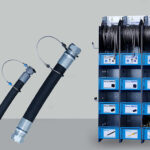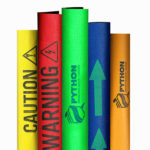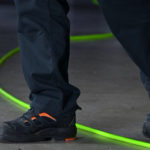By Josh Cosford, Contributing Editor
Hydraulic hoses are crucial in various fluid power industries, helping power heavy machinery and equipment by providing the very conduit through which hydraulic fluid flows. The integrity of these systems relies heavily on the proper connection and disconnection of hydraulic hoses, as mishandling hydraulic hoses can lead to severe accidents and damage. To ensure a safe working environment, reliable machinery and reduced maintenance, you should follow strict safety guidelines when connecting and disconnecting hydraulic hoses.

Before connecting or disconnecting hydraulic hoses, ensure you have the appropriate personal protective equipment. This includes safety goggles to protect your eyes from potential fluid spray, gloves to safeguard your hands, and suitable clothing that covers your skin. PPE acts as a crucial barrier, minimizing the risk of injury due to accidental contact with hydraulic fluids. Some fluid types, especially older, poorly maintained oil, can irritate skin or cause reactions.
Relieving system and localized pressure are critical safety measures before connecting or disconnecting hydraulic hoses. Hydraulic systems operate under high pressure, and releasing this pressure is essential to prevent sudden pressure release, which can lead to severe injuries or damage to equipment. It’s insufficient to simply power down the machine since fluid may still be trapped under pressure. Typically, cycling the directional valves will dump system pressure to the tank, which should only be attempted when loads are safely rested to avoid trapped load pressure. Over time, you’ll learn to recognize the “limp hose” that signals when a pressure-tensioned hose has relaxed.
Contaminants such as dirt, dust, or debris can compromise the integrity of hydraulic systems. Before connecting hoses, ensure that both the hose and connection points are clean. Use a lint-free cloth and approved cleaning agents to remove any particles that might interfere with a secure connection. Hoses should be stored with plugs and caps installed to prevent airborne dust from contaminating them.
Regular inspection of hydraulic hoses and fittings is crucial for identifying potential issues before they escalate. Look for signs of wear, damage, or corrosion, and replace any components that show deterioration. Check for proper labelling and verify that you are using the correct type of hose for the specific application. Ensure that fittings are in good condition and securely fastened to prevent leaks. It also helps to avoid selecting inappropriate thread forms for your application. For example, choose hose ends employing O-rings for sealing rather than tapered threads.
When installing and connecting hydraulic hoses, proper alignment is critical to ensuring a long-lasting, reliable connection. Misalignment can cause stress on the hoses and fittings, leading to premature wear or failure at the point where the hose and crimp meet. Ensure hoses lay naturally with respect to gravity so their own weight does not place pressure upon the crimp as well.
When connecting hydraulic hoses, follow the manufacturer’s guidelines for the specific equipment. Use the correct torque for fittings and ensure that connections are tight. When disconnecting hoses, do so carefully to avoid sudden releases of hydraulic fluid while using appropriate tools, such as wrenches or pliers, to loosen fittings without causing damage.
Safe practices when connecting and disconnecting hydraulic hoses are paramount to maintaining a secure working environment. By following these safety tips, operators can minimize the risk of accidents, injuries, and equipment damage. Regular training on proper procedures and adherence to manufacturer guidelines are essential for ensuring the longevity and efficiency of hydraulic systems while prioritizing the safety of those working with them.






Leave a Reply